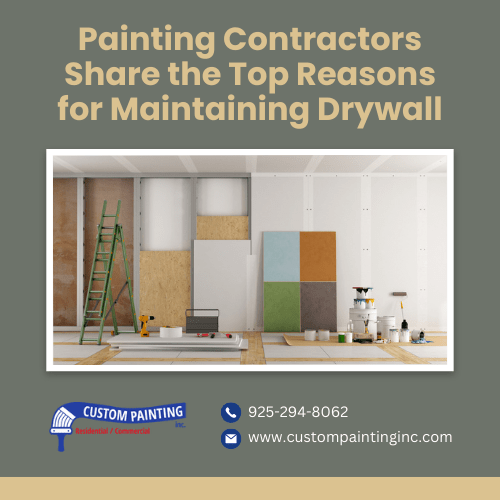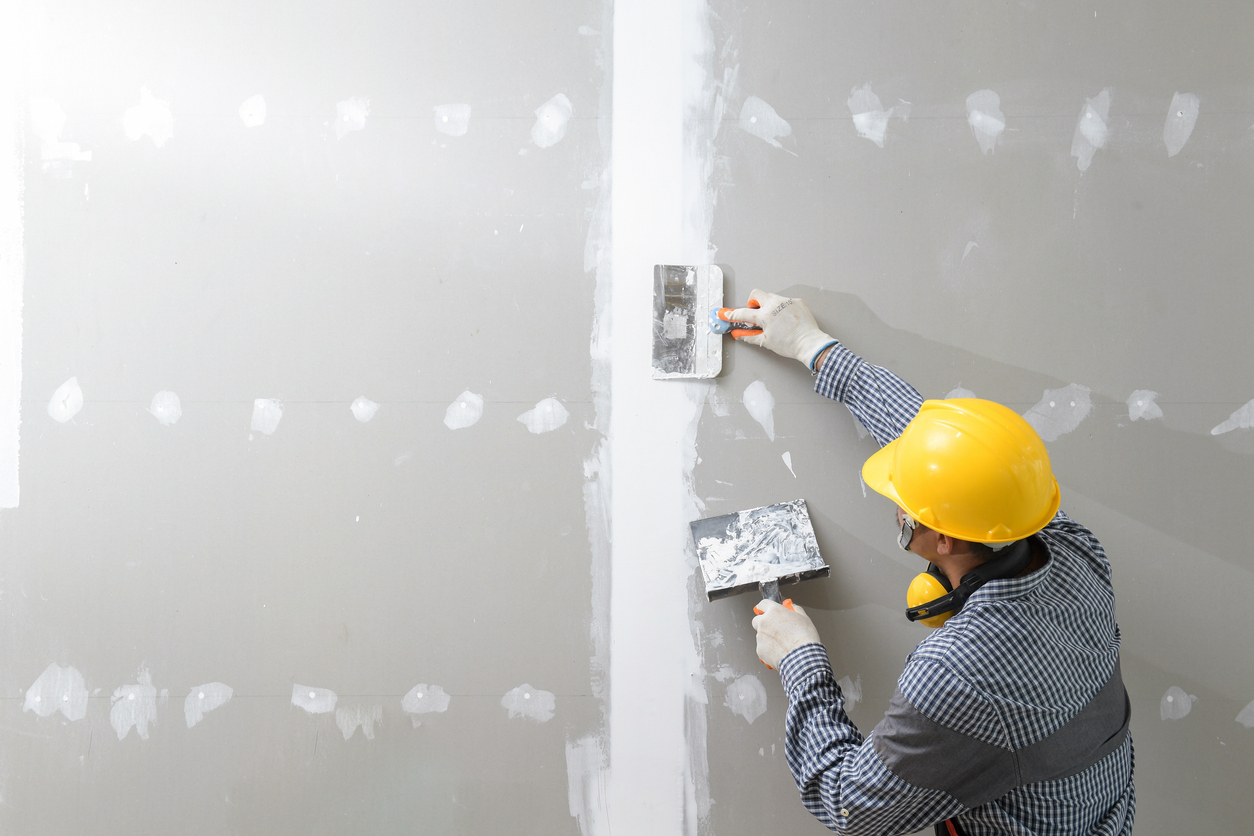Most Livermore homeowners choose drywall for its appearance, affordability, fire resistance, and soundproofing capabilities. However, drywall may need regular maintenance to keep its appearance and stability. Drywall maintenance preserves the interior walls’ structural integrity and aesthetic appeal. Proper upkeep prevents issues like cracks, holes, and moisture damage. Regular maintenance gives a smooth and polished appearance, ultimately enhancing a property’s look and value.
Painting contractors have specialized skills and knowledge essential for effective drywall maintenance. They can identify and repair Drywall damage, ensuring surfaces are properly prepped before painting. Their expertise includes patching holes, sanding surfaces, and applying primers and finishes that protect and enhance drywall. This professional touch ensures a high-quality and long-lasting result that homeowners and businesses can rely on.
Preventing structural damage
When you regularly maintain your drywall, it contributes favorably to your property’s structural integrity. It provides a stable, smooth surface supporting insulation, resistance to fire, and sound transmission. Well-maintained drywall helps distribute loads and adds rigidity to walls and ceilings.
Common issues from neglected drywall include:
- Cracks and holes – They can lead to loss of structural integrity and allow moisture penetration.
- Water damage – It can lead to mold growth and weakening of the drywall, compromising the structure.
- Sagging – This indicates possible water damage or improper installation, leading to further structural problems.
- Mold and mildew – These are health hazards that also degrade the material over time
Aesthetic benefits
Well-maintained drywall enhances a room’s overall appearance. It provides a smooth, clean surface that can be easily painted or decorated. Regular maintenance prevents flaws like cracks and holes, ensuring the drywall remains intact and visually appealing. This upkeep prevents minor issues from worsening, maintaining the drywall’s durability and aesthetic quality.
Cost efficiency
Analysis of how maintaining drywall can save money in the long term
Regular drywall maintenance prevents more significant damage from developing. This proactive approach reduces the need for extensive repairs or full replacements, saving money over time. Well-maintained drywall also helps maintain a home’s overall structural integrity and appearance. It potentially increases a home’s value and reduces long-term renovation costs.
Comparisons of minor maintenance costs versus major repair expenses
Minor maintenance costs, like patching small holes or repainting, are relatively low and can be handled quickly. In contrast, major repair expenses, such as replacing entire drywall sections, are significantly higher due to the labor and materials involved. Addressing minor issues prevents them from escalating into major problems. It can result in substantial cost savings over time.
Health and safety reasons
Overview of health concerns associated with damaged or moldy drywall
1. Respiratory issues
Mold spores can become airborne. When inhaled, they can cause respiratory problems such as coughing, sneezing, and asthma attacks. Individuals with allergies, pre-existing respiratory conditions, or weakened immune systems are particularly vulnerable.
2. Allergic reactions
Mold exposure can trigger allergic reactions, including nasal congestion, eye irritation, skin rashes, and throat irritation. These symptoms can vary in severity, depending on the extent of mold growth and individual sensitivity.
3. Toxic mold exposure
Certain molds, such as Stachybotrys chartarum (black mold), can produce mycotoxins. They are toxic compounds that can cause severe health issues. Prolonged exposure to mycotoxins can lead to neurological problems, chronic fatigue, and severe respiratory problems.
4. Immune system suppression
Long-term mold exposure can weaken the immune system, making individuals more susceptible to infections and illnesses.
Safety risks posed by compromised drywall structures
1. Structural Instability
Damaged drywall, especially if it has absorbed moisture, can lose its structural integrity. It can lead to sagging, cracking, or even collapsing walls or ceilings, posing a risk of injury from falling debris.
2. Electrical hazards
Moisture in drywall can infiltrate electrical systems. This issue can lead to short circuits, electrical fires, or electrocution risks. Water-damaged drywall near electrical outlets, switches, or wiring can be dangerous.
3. Mold growth and spread
Compromised drywall provides an ideal environment for mold growth. If not addressed promptly, mold can spread to the building’s other areas, worsen health issues, and lead to more extensive and costly repairs.
4. Hidden damage
Water-damaged drywall can hide other issues. They include rot in wooden structures, rust in metal components, or pest infestation. These hidden problems can exacerbate structural damage and health risks over time.
Maintaining property value
How maintained drywall can positively affect property value
Maintaining drywall enhances a property’s aesthetic appeal and structural integrity. Here are ways well-maintained drywall can positively affect property value:
- Aesthetic appeal — Smooth, crack-free, and well-painted drywall creates a visually appealing interior. It makes the property more attractive to potential buyers.
- Structural integrity – Mold and insect infestation compromise a home’s structure and safety. Properly maintained drywall prevents these issues.
- Cost savings – Potential buyers appreciate properties that require minimal repairs. Well-maintained drywall indicates that the property has been cared for. It reduces the perceived future maintenance costs.
- Marketability—Homes with well-maintained interiors often sell faster and at higher prices. They also leave a better first impression during showings and open houses.
Insights from real estate professionals on the impact of interior conditions on property assessments
Real estate professionals often emphasize the importance of interior conditions when assessing property value. Here are some key insights:
- First impressions matter – Real estate agents report that a home’s interior condition significantly impacts buyers’ first impressions. It can influence their willingness to make an offer and the amount they are willing to pay.
- Value perception – Well-maintained interiors must have clean, updated, and damage-free spaces. Buyers will perceive the property with clean and well-kept interiors as more valuable. Conversely, visible issues like cracked drywall, peeling paint, or outdated fixtures can lower perceived value.
- Inspection reports—Real estate professionals note that interior conditions often affect home inspection outcomes. Homes in good condition generally have fewer issues flagged, which makes the buying process smoother and potentially leads to higher offers.
- Investment potential—Buyers looking for investment properties often seek move-in-ready homes. Properties with well-maintained interiors require less immediate investment, making them more attractive and competitive in the market.
- Market trend – Real estate professionals highlight that in competitive markets, the interior condition can be a deciding factor. Homes with modern, well-kept interiors tend to sell at a premium compared to those requiring significant repairs or updates.
Maintaining drywall and other interior elements in a home is crucial for property upkeep. It can significantly influence its market value and appeal to buyers.
Professional tips for drywall maintenance
Advice from painting contractors on regular maintenance routines:
- Regularly inspect painted surfaces for signs of wear, damage, or mildew.
- Clean surfaces with mild soap and water to remove dirt and grime.
- Touch up small areas with leftover paint to keep the finish looking fresh.
- Keep an eye on caulking around windows and doors, reapplying as needed to prevent moisture damage.
Recommended tools and products for DIY drywall maintenance:
- Tools: Utility knife, putty knife, sanding sponge, drywall saw, T-square, and a drill with screwdriver bits.
- Products: Joint compound, drywall tape, drywall screws, primer, and touch-up paint.
Conclusion
Professional painters know the importance of well-maintained drywall. Regular inspection and prompt maintenance effectively address common drywall issues, thus avoiding further complications. Drywall maintenance helps prevent structural damage, enhance aesthetic appeal, keep living spaces healthy, save money in the long run, and potentially increase a property’s market value.
For optimal results, it’s highly advisable to consult with a professional for drywall maintenance. Their expertise ensures the job is done correctly, efficiently, and safely, saving you time and potential frustration.
Contact the experts from Custom Painting, Inc. for your San Ramon home’s drywall repair, paint, and maintenance needs. Rest assured that we will bring your projects to their best finish. Call us at 925-294-8062 or message us to get your free job estimate.



